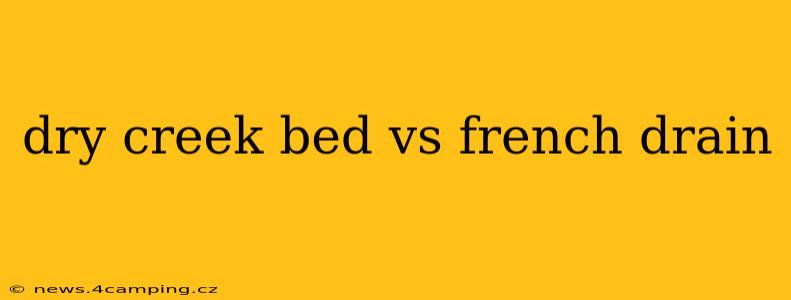Choosing between a dry creek bed and a French drain can be tricky, as both address water drainage issues but in different ways. Understanding their respective strengths and weaknesses is key to making the right decision for your property. This comprehensive guide will delve into the specifics of each system, helping you determine which is the best solution for your landscaping needs.
What is a Dry Creek Bed?
A dry creek bed, also known as a dry river bed or dry stream bed, is an aesthetically pleasing landscaping feature designed to mimic a natural creek. It's primarily a decorative element that can help manage surface water runoff, but its primary function isn't drainage. It typically consists of carefully placed rocks, gravel, and sometimes plants, creating a visually appealing pathway for water to flow during heavy rainfall. The water isn't contained within pipes or channels like a French drain; instead, it simply flows over the surface of the rocks and gravel.
Pros:
- Enhanced Aesthetics: Dry creek beds significantly improve curb appeal, adding a natural, charming element to your landscape.
- Erosion Control (Limited): They can help to slow down and direct surface water flow, minimizing erosion in some cases.
- Low Maintenance (Relatively): Once installed, they require minimal upkeep, mainly involving occasional weeding.
Cons:
- Limited Drainage Capacity: They are not effective at managing large volumes of water or subsurface drainage issues.
- Potential for Flooding: In areas with intense rainfall, a dry creek bed might overflow, leading to potential flooding or water damage.
- Not Suitable for All Climates: They might not be suitable in areas with extreme weather conditions or frequent heavy downpours.
What is a French Drain?
A French drain is a subsurface drainage system designed to collect and redirect excess groundwater or surface runoff. It consists of a perforated pipe surrounded by gravel, typically buried underground. This system effectively channels water away from problem areas, preventing issues like soggy lawns, foundation damage, and basement flooding. The gravel acts as a filter, allowing water to enter the pipe while preventing soil from clogging it.
Pros:
- Effective Drainage: French drains efficiently handle large volumes of water and subsurface drainage.
- Prevents Water Damage: They protect structures and landscaping from water damage by diverting water away from vulnerable areas.
- Long-Lasting Solution: Properly installed French drains provide a long-term solution to drainage problems.
Cons:
- Higher Installation Cost: French drains are more expensive to install than dry creek beds due to excavation and material costs.
- Less Aesthetically Pleasing: They are less visually appealing than dry creek beds, as they are typically hidden underground.
- Potential for Clogging: If not properly maintained, French drains can clog with sediment, reducing their effectiveness.
Dry Creek Bed vs. French Drain: Which One Should I Choose?
The best choice depends on your specific needs and circumstances. Consider these factors:
- Drainage Needs: If you have significant drainage issues, a French drain is the better option. If you primarily want to manage surface runoff in a visually appealing way and don't have severe drainage problems, a dry creek bed might suffice.
- Budget: French drains are more expensive.
- Aesthetic Preferences: Dry creek beds offer a more aesthetically pleasing solution, while French drains are typically hidden.
- Climate: Areas with frequent heavy rainfall might benefit more from a French drain's superior drainage capacity.
- Soil Type: The type of soil can affect the effectiveness of both systems. Clay soil, for example, may impede water flow in a dry creek bed.
How Much Does a Dry Creek Bed Cost?
The cost of a dry creek bed varies greatly depending on factors like the size, complexity of the design, materials used, and labor costs. Generally, expect to pay somewhere between a few hundred dollars for a small project to several thousand dollars for a more extensive installation.
How Much Does a French Drain Cost?
Similar to dry creek beds, the cost of a French drain is highly variable. Factors affecting the price include the length of the drain, the depth of installation, the type of pipe used, and the overall complexity of the project. Expect to pay anywhere from a few hundred dollars for smaller projects to several thousand dollars for more extensive installations.
Can I Combine a Dry Creek Bed and a French Drain?
Yes, you can often combine both systems. A French drain can handle subsurface drainage issues, while a dry creek bed can manage surface runoff and enhance the aesthetics of the landscape. This combined approach can provide the best of both worlds.
By carefully considering these factors, you can choose the drainage solution that best suits your landscape's needs and your budget. Remember to consult with a landscaping professional for a personalized assessment and expert advice.
